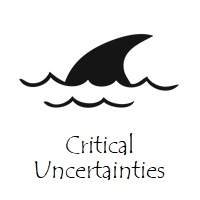
Critical Uncertainties is a powerful Liberating Structure
Critical Uncertainties helps to develop strategies for dealing with a range of plausible yet unpredictable futures. It enables groups to quickly test the viability of current strategies and build their capacity to respond quickly to future challenges.
This Liberating Structure prepares a group for strategy making. It does not produce a plan to be implemented as designed but rather builds resilience: the capacity to actively shape the system and be prepared to respond to surprise.
This means being better able to see different futures unfolding, better prepared to act in a distributed fashion, and more ready to absorb disruptions resiliently.
Four Structural Elements
1. Structuring Invitation
- Invite the group to identify and explore the most critical and uncertain “realities” in their operating environment or market
- Then invite them to formulate strategies that would help them operate successfully in those different situations
2. How Space Is Arranged and Materials Needed
- Four groups of chairs around tables
- Paper, Post-it notes, flip charts, or tapestry paper for each group
3. How Participation Is Distributed
- Everyone responsible for planning and executing strategy is included
- Everyone has an equal opportunity to contribute
- Have a group large and diverse enough to break it up into four separate small groups to develop the four scenarios and related strategies. If not, make two small groups
4. Sequence of Steps and Time Allocation
- Describe the sequence of steps. 2 min.
- Invite participants to make a list of uncertainties they face by asking, “In your/our operating environment, what factors are impossible to predict or control their direction?” 5 min.
- Prioritize the most critical factors by asking, “Which factors threaten your/our ability to operate successfully?” 10 min.
- Based on the group’s history and experience, select the two most critical and most uncertain (X and Y). 5 min.
- Create a grid with two axes—X & Y—with a “more of <— —> less of” continuum for the factor to be represented on each axis. Four quadrants are created. (See example below.) 5 min.
- Each of the four groups creatively names and writes a thumbnail scenario for one of the quadrants. 10 min.
- The four groups share their scenarios briefly. 2 min. each
- Each group brainstorms three strategies that would help the group operate successfully in the scenario that it has described. 10 min.
- The four groups share their strategies briefly. 2 min. each
- The whole group sifts results to identify which strategies are robust (strategies that can succeed in multiple quadrants) and which are hedging (strategies that can succeed in only one scenario but protect you from a plausible calamity). The balance of strategies can succeed only in one scenario. 10 min.
- Each small group debriefs with What, So What, Now What? 10 min.
- The four groups share their debriefs and the whole group makes first-steps decisions about their Now What. 10 min.

Purposes and Objectives
- Teams have an interaction pattern at hand that can support them create resilient strategies.
- Test the viability of current strategies by exposing assumptions and uncertainties
- Increase capacity of everyone to adapt quickly and absorb disruptions resiliently
- Differentiate priorities in terms of robust and hedging strategies
- Develop more organization-wide confidence in managing the unknowable future
Tips
- Do this exercise step-by-step. It can be an overwhelming, mind-crushing structure. Don’t explain everything upfront.
- Allow them to focus on the content, don’t get the groups distracted by the steps & rounds of the structure itself.
- For each scenario, invite small groups to dramatize a typical client interaction or product from the future that puts your strategies into play. This might even result in Improv Prototyping.
- Post-it notes with colored themes help with combining and recombining ideas. For example, yellow post-it’s are used for the name of each scenario, blue for the strategies, etc
- When brainstorming uncertainties, recall predictions-gone-wrong and events that caught the group off guard
- Have fun with naming each quadrant (song and book titles work nicely)
Examples
- Help expose assumptions and uncertainties and define next steps
- Showing management how to involve everyone in shaping the future of the organization
- Growing the self-organizing capabilities of the team by having them think of the most critical and uncertain realities they might face
- For exploring what features should be included in a product or service that will be launched
- For counseling youth in unstable settings, likely to drop out of school or start living on the street
- Unite the team and allow to adapt to changes more quickly


